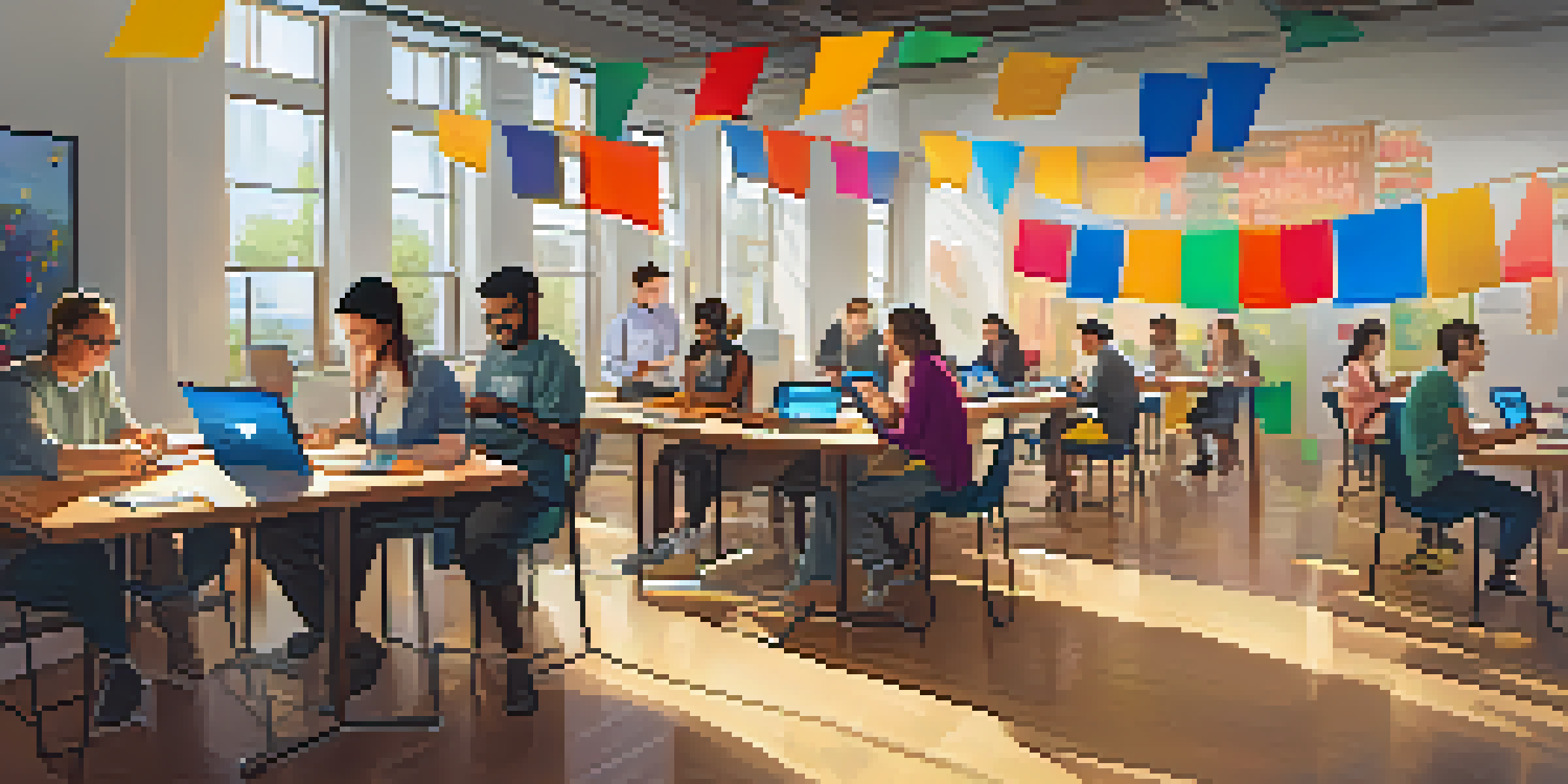The Role of Play in Adult Learning Through Gamification

Understanding Gamification in Adult Learning
Gamification involves incorporating game-like elements into non-game contexts, particularly in learning environments. For adults, this approach can make the learning process more engaging and enjoyable. By using points, badges, and leaderboards, educators can tap into the natural human desire for achievement and competition.
Gamification is the application of game-design elements and game principles in non-game contexts.
This method transforms traditional learning into an interactive experience, encouraging active participation. Imagine attending a workshop where you collect points for completing tasks or answering questions correctly, making the experience feel less like a chore and more like a fun challenge. Such strategies not only enhance motivation but also improve retention of information.
As we explore the role of play further, it’s important to recognize that gamification isn’t just about fun; it’s also about effective learning. By integrating play, educators can create a safe environment for adults to experiment and learn from their mistakes without the fear of failure.
The Psychological Benefits of Play in Learning
Play has a unique way of engaging the brain, which is crucial for adult learners. When adults participate in playful learning, they often experience reduced anxiety and increased creativity. This sense of play encourages risk-taking, enabling learners to explore new ideas and concepts without the pressure of strict evaluation.

Additionally, play stimulates the release of dopamine, the brain's feel-good chemical, which enhances motivation and reinforces learning. Think about it: when you enjoy what you’re doing, you're more likely to stay focused and absorb information. This is particularly beneficial in adult learning, where maintaining attention can sometimes be a challenge.
Gamification Enhances Adult Learning
Incorporating game-like elements makes the learning process for adults more engaging and enjoyable.
Moreover, play fosters social connections and collaboration among learners. Engaging in activities together can create a sense of community, making the learning process more enjoyable and less isolating.
Creating a Gamified Learning Environment
To effectively incorporate gamification into adult learning, it’s essential to design an environment that promotes engagement and interaction. This could involve using digital platforms that allow for real-time feedback and collaboration among participants. For instance, online quizzes that provide instant scores can keep learners on their toes.
The real power of gamification is that it taps into our natural desires for achievement, competition, and social interaction.
Incorporating storytelling elements can also enhance the gamification experience. By framing learning objectives within a narrative, learners can feel like they are part of a larger adventure, making the content more relatable and memorable. This storytelling aspect connects with adults on a personal level, making the learning process more impactful.
Finally, it’s important to tailor the gamified elements to the audience’s preferences and skills. Just as not all games appeal to everyone, not every gamification strategy will resonate with all adult learners. Understanding your audience is key to creating an effective gamified learning experience.
Challenges of Implementing Gamification
Despite the benefits, implementing gamification in adult learning is not without its challenges. One common obstacle is the potential for disengagement if the game elements are poorly designed or not relevant to the learning objectives. For example, if the competition feels forced or unrelated, it can lead to frustration rather than motivation.
Another challenge is the varying levels of comfort with technology among adult learners. While some may thrive in a digital gamified environment, others could feel overwhelmed. It's vital to provide support and options to ensure that everyone can participate fully.
Play Reduces Anxiety and Boosts Learning
Engaging in playful learning helps reduce anxiety and fosters creativity, leading to better retention of information.
Moreover, instructors must strike a balance between fun and educational value. Overemphasis on game mechanics can overshadow the actual learning goals, leading to superficial engagement rather than deep understanding.
Case Studies: Success Stories of Gamification
Looking at real-world examples can provide insight into the effectiveness of gamification in adult learning. One notable case is a corporate training program that used gamified elements to enhance employee engagement. By incorporating simulations and role-playing scenarios, the company saw a significant improvement in knowledge retention and employee satisfaction.
Another example comes from a language learning platform that leverages gamification to motivate adult learners. Users earn rewards for completing lessons and can compete with friends, fostering a sense of community and accountability. This approach has led to higher completion rates and increased enthusiasm for learning a new language.
These success stories illustrate that when done right, gamification can revolutionize the adult learning experience, making it more enjoyable and effective.
Integrating Technology in Gamified Learning
Technology plays a crucial role in enhancing gamification in adult learning. With the rise of mobile applications and online platforms, learners can access gamified content anytime, anywhere. This flexibility allows adults to learn at their own pace, an essential factor for busy professionals juggling work and personal commitments.
Furthermore, data analytics can provide valuable insights into learners' progress and engagement levels. Educators can tailor their approaches based on this feedback, making adjustments to keep participants motivated and on track. For instance, if a learner struggles with a particular module, targeted support can be offered to help them succeed.
Technology Fuels Gamified Learning
Advancements in technology, such as mobile apps and data analytics, enhance the flexibility and effectiveness of gamified learning experiences.
Finally, virtual and augmented reality experiences are pushing the boundaries of gamified learning. Imagine being able to practice a skill in a lifelike environment without any real-world consequences. This kind of immersive experience can significantly enhance learning outcomes for adult learners.
Future Trends in Gamification for Adult Learning
As we look ahead, the landscape of adult learning through gamification is set to evolve further. One emerging trend is the use of artificial intelligence to create personalized learning experiences. AI can analyze individual learning patterns and adapt content accordingly, ensuring that each learner is challenged at the right level.
Another trend is the growing emphasis on social learning through gamification. Platforms that facilitate collaboration among learners will likely gain traction, allowing adults to learn from one another while enjoying the competitive aspects of games. This could lead to richer learning experiences and stronger community ties.

Finally, ongoing research into the neuroscience of play will continue to inform best practices in gamification. Understanding how the brain responds to play will help educators design more effective learning environments that harness the power of play for adult learners.